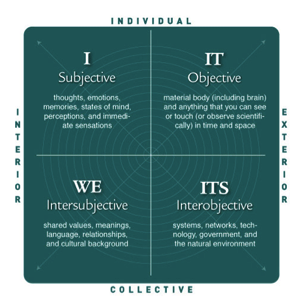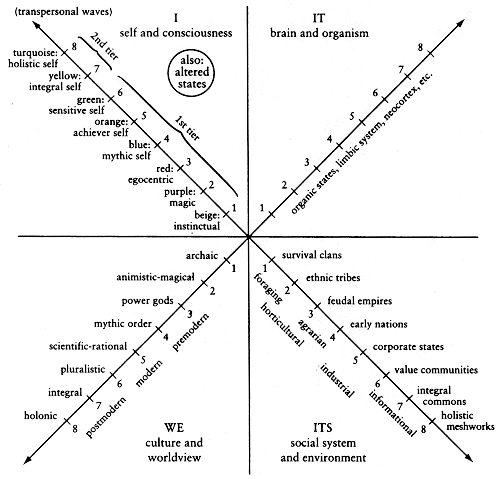One of the topics that I am currently reading up on is the Theory of Everything(TOE) by Ken Wilber and its associated integral model. I am finding the topic extremely fascinating, and have to admit that I am still in the early learning stages. The Theory of Everything can be abstract and complex, and I have more learning to do before I can claim sufficient knowledge of it. I will attempt however to explain some of the theory that I have learned, and will also illustrate the integral model and how it would apply to Technology, Innovation, and Creativity in Sustainability. I highly recommend reading up on the subject however if you are interested in learning more.
The Theory of Everything is a theory devised by Wilber that attempts to explain where we are at today and where we are headed. It is a theory that includes all the realms, models, and memes that are known today. It’s purpose is to include and integrate everything in a holistic view. It opens the path for the second tier development of consciousness and outlines an integral model that must be adopted to ensure a successful design and implementation.
Wilber defines the integral model as one that integrates the physical, emotional, mental, and spiritual realms. The integral model contains four different quadrants; Intentional, Behavioral, Cultural, Social. These quadrants are also known as I, IT, WE, ITS respectively. The integral model provides a holistic approach to look at the different issues and fields at hand. Here are some figures that show the four quadrants with an explanation of each.
In the Theory of Everything, Wilber shows how the integral approach is the most superior in designing and managing the major sectors of life. He shows how it applies to the economy, education, politics, science, health care, and psychology. He outlines the benefits of using this model over the limited views and one-sided approaches that exist today.
If I were to apply the integral approach to Technology, Innovation, Creativity in Sustainability, I would apply it as such:
IT: Objective: This upper right quadrant represents the realm where all of technology design and implementation occurs today. It represents the physical and material world. An integral approach would continue to embrace this quadrant in addition to other quadrants.
I: Intention: This upper left quadrant is all about the individual being, motivation, and intention. It is paramount that an integral approach to TICS includes this quadrant. In this approach, the individual intention and motives are required to ensure that they embrace TICS. TICS will not just require the technology, but the individual’s behavioral change and motivation to embrace TICS’s implementation and utilization.
WE: Cultural: The individual does not exist in a vacuum. It is the inter-personal relationships, community, and culture that enforce and propagates the individual’s behavior changes. The WE quadrant is important to an integral approach as it ensures that TICS is embraced on a community level, and that the community level support is present to ensure its success.
ITS: Social: The last but not least quadrant is the lower left, which emphasis the social and systemic solutions to TICS. In order to embrace technology, innovation, and creativity for sustainability, the underlying system or structure must be supportive of such an embrace. It is important to engage this quadrant for a holistic approach of TICS.
I can argue that this Integral approach to TICS is the one and only approach that would yield the thought after results. If one of the quadrants is missing, the overall solution would be missing an important piece that would limit its success.
Thank you for reading on. I will cover more on this topic in the future. What are your opinions on the integral approach to TICS?


